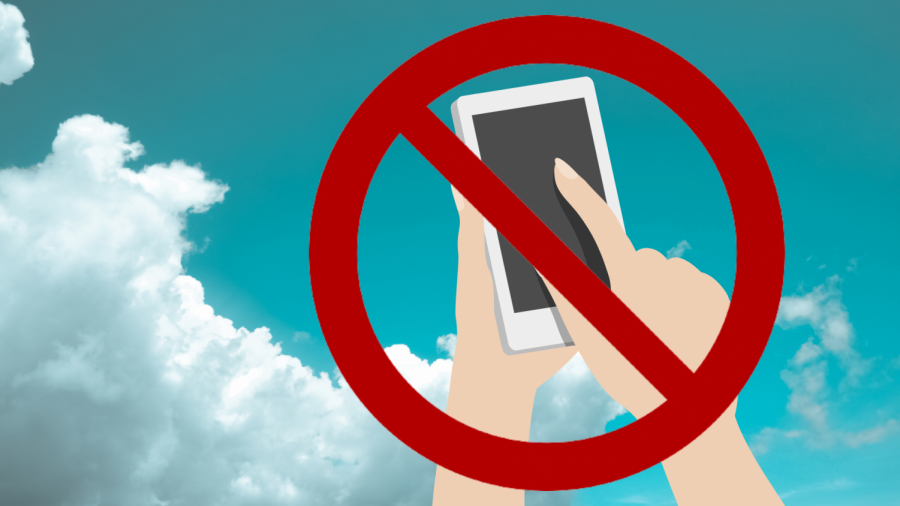Students and Their Cell Phones: A Retiring Teacher’s Parting Challenge
Mrs. Cavaliere and Mrs. Roccisano
Over the years, Ms. Uruburu noticed that student disengagement grew proportionally to students’ increased access to technology.
May 3, 2021
As it will be for many Northport-East Northport faculty and staff, the 2020–2021 academic year will be the last for Ms. Pamela Uruburu, an English teacher at Northport High School. After a career spanning three decades — with 28 years of service to the Northport-East Northport UFSD — Ms. Uruburu is retiring in June.
Much has changed in the academic world since Ms. Uruburu began teaching in 1990. When students needed access to a computer, they had to find a spot at one of the few stations available in the computer room. When students needed to make a call, they had to use a payphone. Now, every student has immediate access to a computer — in the form of a Chromebook — and a phone call is only a tap away.
Over the years, Ms. Uruburu noticed that student disengagement grew proportionally to students’ increased access to technology.
But in the past year, disengagement has worsened — or rather, gotten more noticeable. While learning during the COVID-19 pandemic has certainly presented challenges, Ms. Uruburu believes that student disengagement in class is attributable to more than just remote classes. In breakout rooms, students communicated through the chat feature, rather than unmuting themselves and speaking. And despite the return to in-person instruction five days a week, Ms. Uruburu notes that students are still hesitant to engage in discussion with each other. When Ms. Uruburu sets aside time at the end of class to encourage students to talk with one another, students immediately whip out their phones.
Cell phone use also impacts homework. Ms. Uruburu finds that while doing homework — interrupted by a constant stream of texts and Snapchats — students find themselves distracted, prolonging assignment time and reducing quality of work.
Cell phones, however, do not only interfere with school; Ms. Uruburu emphasizes that cell phone use inhibits active engagement in life. As she says, “Learning to navigate potentially awkward interactions, connecting with others without being in control of the interaction, genuine downtime, and moments of quiet reflection are part of a healthy interaction with the real world.”
So, as a parting gift to her classes, Ms. Uruburu offered a challenge that she believes teaches the “most beneficial” lesson of all.
In exchange for extra credit (though Ms. Uruburu argues that the “personal rewards” exceed “academic benefit”), Ms. Uruburu’s willing students (with their parents’ permission) gave her their phones to be held in a safe place for 48 hours. Upon the return of their devices, students wrote about their experience in being disconnected from the digital world.
After partaking in the challenge, Jennifer Martin — a student in Ms. Uruburu’s English 10 class — was, at first, skeptical of the challenge, but by the 47th hour, noticed the real benefit of the experience. “By the final day, the surges of phone cravings subsided almost entirely,” she says. “In all honesty, I cherished the 48 hours in absence of my phone. While I did have moments of denial to such positive change, I experienced self-reflection more robust than any other mental state.”
A common theme running throughout Ms. Uruburu’s student responses was that of significant doubt. Not only did the students doubt their own ability to thrive during this challenge, parental figures often had their uncertainty as well. Much of the students’ responses noted the furrowed brow parents gave their children when presented with Ms. Urburu’s idea.
“When I approached my parents with this idea”, student Jacqueline Bonura recalls, “they thought it was great but doubted I could do it. Their doubt actually caused me to have second thoughts about being a part of the challenge. I questioned if I could live as little as three days. When these thoughts popped into my head, I realized that I needed to do it.”
When students finally overcame the societal pressures of self-doubt, it seems an entirely new person emerged out of their phone’s shadow. Numerous students cited a significant increase in creativity and active enjoyment of life.
A senior who wished to stay anonymous writes, “I think the biggest impact that the lack of my phone had was on what I did with my free time and my mood. I spent time reading on the porch in my backyard, painting a portrait of my cousin’s dog, going for bike rides with my parents, taking photographs for my art class, and watching movies with my family. I have always enjoyed these activities, but something about the phone makes it so easy to get absorbed and distracted for hours.” Other students of Ms. Uruburu attribute their phone’s absence to increased levels of productivity and overall quality of life.
Perhaps Ms. Uruburu is on to something. Have students squeezed all of life into a 3.0” by 6.0” rectangular box? Ms. Uruburu’s challenge has instilled that message in its participants; that there is more to life than what fits in your pocket.




